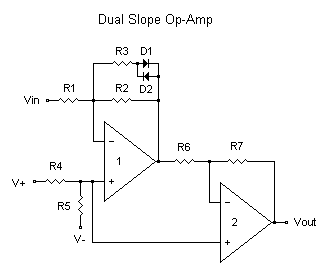
Microphone | Op-Amp | Transistor
Question or Comment | Home

 This microphone circuit works with Radio Shack and Panasonic electret condenser microphones.
This microphone circuit works with Radio Shack and Panasonic electret condenser microphones.
 This is the microphone circuit combined with a pre-amp.
This is the microphone circuit combined with a pre-amp.
 This is a single-supply inverting op-amp.
This is a single-supply inverting op-amp.
 This is a single-supply non-inverting op-amp.
This is a single-supply non-inverting op-amp.
 This is a single-supply, non-inverting op-amp that converts dual supply signal into single supply (Vs/2 ref.).
This is a single-supply, non-inverting op-amp that converts dual supply signal into single supply (Vs/2 ref.).
 This is a dual slope op-amp. The initial gain of the primary op-amp#1 is determined by R2/R1. Once the output of op-amp#1 reaches the barrier voltage of one of the diodes D1 or D2 (600mv), current starts to pass through R3. Now the gain becomes a combination of the series resistance of R3 plus the virtual resistance of the diode's barrier voltage and the parallel resistance of R2. Adjust the gain of the primary op-amp#1 so the attenuation starts at the desired level and adjust R3 to give the amount of attenuation desired. Adjust the gain of op-amp#2 to give final gain desired. This circuit produces a very smooth transition to the secondary gain. I have added D1, D2 and R3 to the mic amplifier circuit and it performs well, amplifying low volume sounds, while at the same time attenuating (not clipping) the high volume sounds. Vin may be A.C. coupled with a capacitor in series with R1.
This is a dual slope op-amp. The initial gain of the primary op-amp#1 is determined by R2/R1. Once the output of op-amp#1 reaches the barrier voltage of one of the diodes D1 or D2 (600mv), current starts to pass through R3. Now the gain becomes a combination of the series resistance of R3 plus the virtual resistance of the diode's barrier voltage and the parallel resistance of R2. Adjust the gain of the primary op-amp#1 so the attenuation starts at the desired level and adjust R3 to give the amount of attenuation desired. Adjust the gain of op-amp#2 to give final gain desired. This circuit produces a very smooth transition to the secondary gain. I have added D1, D2 and R3 to the mic amplifier circuit and it performs well, amplifying low volume sounds, while at the same time attenuating (not clipping) the high volume sounds. Vin may be A.C. coupled with a capacitor in series with R1.
 Peak detector circuit.
Peak detector circuit. This is an RS232 to Open-Collector circuit.
This is an RS232 to Open-Collector circuit.
 This is one half of a H-bridge driver.
This is one half of a H-bridge driver.